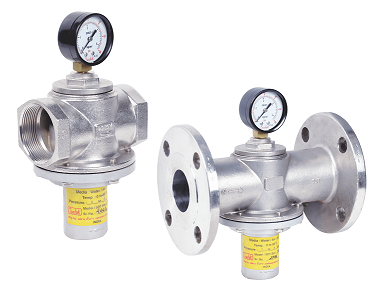The Ultimate Guide of Pressure Reducing Valves (PRV)

The pressure is the most important element for the fluid. Either it is for air pressure or water pressure. Sometimes we need high pressure and sometimes we have to decrease the flow pressure. Here we will find out the Pressure Reducing Valve, in all 360° aspects like How does it work? Why do we need it? And How many types and all, So let’s start.
What is Pressure Reducing Valve?
The pressure reducing valve is not for opening and closing the flow but this valve is used to decrease the flow of pressure. The valve maintains constant outlet pressure regardless of inlet pressure. It reduces the pressure accuracy of 1% to 10% of the inlet pressure of Air, Water, Steam, and Gas.
Types of PRV and How Does Pressure Reducing Valve Works?
(1) This is a normally open condition valve that has a spring connected diaphragm inside the body. The fluid has to pass through the spring connected diaphragm and the diaphragm sets for the desired outlet flow pressure. This is a simple mechanism of Pressure Reducing Valve called Direct-acting, which can reduce the outlet pressure up to 10% of inlet pressure.

(2) Pilot Operated Pressure Reducing Valve: This type of pressure reducing valve has two separate valves- a pilot and main valve – in one unit. This valve’s designed the same as a direct-acting valve. In this valve, there is a control chamber that receives flow from the inlet port by a tiny downstream line.
In this Pilot Operated Valve, When consumption of fluid increase at the outlet point
- the tiny downstream pressure drops
- Pilot opens
- The control chamber pressure drops and the main valve opens
And when consumption of fluid decreases at the outlet point
- the tiny downstream pressure rises
- Pilot closes
- The control chamber pressure rises and the main valve closes
When Upstream pressure at the inlet point decreases
- the tiny downstream pressure drops
- Pilot opens
- The control chamber pressure drops and the main valve opens
When Upstream pressure at the inlet point increases
- the tiny downstream pressure rises
- Pilot closes
- The control chamber pressure rises and the main valve closes
Why install PRV?
As we all know that PRV the pressure reducing valves reduces the pressure of the flow, in many industries store fluid materials in a huge quantity. When they need to take in use and are going to release them in pipelines, the fluid comes out with high pressure and this fluid could damage or leak the pipelines.
To prevent unexpected losses we have to install PRV, even though we have already installed PRV in our residential buildings and our home’s water lines. The reason is the same as described above, to prevent unnecessary damages to pipelines, faucets, and floor tiles it is the ideal equipment.
How to Choose Correct PRV?
As we read above that there are two major types of Pressure Reducing Valves available and we have to choose one of them for the application. Direct-acting PRV reduces the pressure-flow up to 10% of inlet pressure weather Pilot operated PRV has many other types available like Double Diaphragm Pressure Reducing Valve, so we can’t bind any limit for this pilot operated valve.


